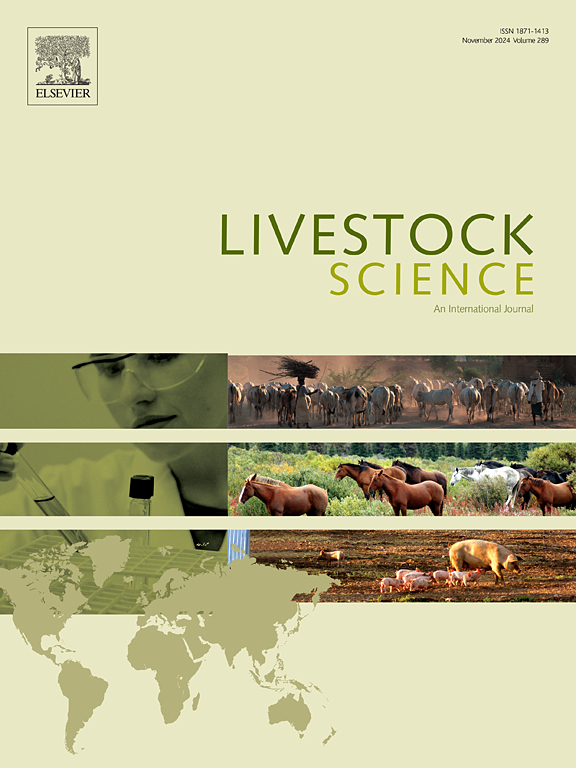低增重和宫内生长受限新生仔猪的存活率预测和评估方法
IF 1.8
3区 农林科学
Q2 AGRICULTURE, DAIRY & ANIMAL SCIENCE
引用次数: 0
摘要
现代母猪产仔数的增加导致了体重不足和宫内生长受限(IUGR)仔猪的出生。本研究旨在预测出生后第 1 天和第 5 天体重(BW)和体重增加(BWG)较低的新生仔猪的存活率。研究还试图确定IUGR的物理特性和替代评估方法是否可作为识别低体重和低增重仔猪的可靠参数。对 108 头仔猪([Landrace × Yorkshire] × Duroc)的物理特性进行了测量。30 位评估员使用另一种方法提供了 IUGR 评分(Cronbach's α 超过 0.9)。这些分数与使用传统评估方法的分数进行了比较,并将仔猪分为正常组、轻度 IUGR 组和严重 IUGR 组。结果表明,出生后第一天的体重与 IUGR 评估中获得的头部和左眼评分、直肠温度和体长高度相关(均为 P <0.05)。除左眼评分外,这些相关性在第 5 天之前都保持显著(P < 0.05)。在常规的 IUGR 评估中,正常仔猪的头评分、第 1 天和第 5 天的体重指数以及体长(不包括头冠到臀部的长度和眼长)均高于 IUGR 仔猪(P < 0.05)。在体重指数方面,以 0 g 为标准,体重指数为负数的仔猪的头部评分高于体重指数为正数的仔猪(P < 0.05),而 IUGR 测定的其他身体形态评分和物理特性与体重指数无关。当以平均增重(660 克)为标准时,BWG 为 660 克的仔猪比 BWG 为 660 克的仔猪体长长(P < 0.05)。然而,形态评分和仔猪性状并未表现出显著差异。总之,在仔猪出生后五天内,观察到其体重、体重总重、体型特征和 IUGR 评分存在显著差异,这突出表明了对低活力仔猪进行适当管理以优化其存活率的重要性。此外,我们的研究结果表明,头评分评估可能是识别IUGR仔猪的一种可靠、有效的方法。本文章由计算机程序翻译,如有差异,请以英文原文为准。
Viability prediction and evaluation methods for neonatal piglets with low body weight gain and intra-uterine growth restriction
Increased litter sizes of modern sows have led to the birth of underweight and intra-uterine growth restriction (IUGR) piglets. This study aimed to predict the viability of neonatal piglets with low body weight (BW) and body weight gain (BWG) in day 1 and day 5 after birth. It also sought to determine if physical properties and alternative evaluation methods for IUGR could serve as reliable parameters for identifying piglets with low BWG. The physical characteristics of 108 piglets ([Landrace × Yorkshire] × Duroc) were measured. Thirty evaluators provided IUGR scores using an alternative method (Cronbach's α exceeding 0.9). These were compared with those using the conventional evaluation method, and the piglets were classified into normal, mildly IUGR, and severe IUGR groups. In the results, BW on the first day after birth was highly associated with head and left eye scores obtained in the IUGR evaluation, rectal temperature, and body lengths (P < 0.05 for all). These associations remained significant until day 5 (P < 0.05), except for the left eye score. In the conventional IUGR evaluation, head score, body mass index on days 1 and 5, and body lengths (excluding crown-to-rump and eye lengths) were higher in normal piglets than those of IUGR piglets (P < 0.05). Regarding BWG, using 0 g as the standard, piglets with negative BWG showed higher head scores than those with positive BWG (P < 0.05), while other body morphology scores for IUGR determination and physical properties were unrelated to BWG. When average weight gain (660 g) was used as the standard, piglets with BWG >660 g had longer body lengths than those with BWG <660 g (P < 0.05). However, morphology scores and piglet traits did not exhibit significant differences. In conclusion, significant variations were observed in BW, BWG, physical traits, and IUGR scores of piglets within five days after birth, highlighting the importance of proper management of low-vitality piglets to optimise their survival. Furthermore, our findings suggest that head score assessment may be a reliable, efficient method for identifying piglets with IUGR.
求助全文
通过发布文献求助,成功后即可免费获取论文全文。
去求助
来源期刊

Livestock Science
农林科学-奶制品与动物科学
CiteScore
4.30
自引率
5.60%
发文量
237
审稿时长
3 months
期刊介绍:
Livestock Science promotes the sound development of the livestock sector by publishing original, peer-reviewed research and review articles covering all aspects of this broad field. The journal welcomes submissions on the avant-garde areas of animal genetics, breeding, growth, reproduction, nutrition, physiology, and behaviour in addition to genetic resources, welfare, ethics, health, management and production systems. The high-quality content of this journal reflects the truly international nature of this broad area of research.
 求助内容:
求助内容: 应助结果提醒方式:
应助结果提醒方式:


